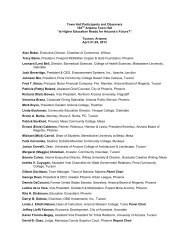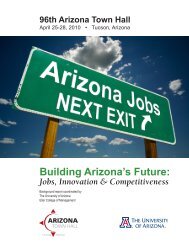Background Report - Arizona Town Hall
Background Report - Arizona Town Hall
Background Report - Arizona Town Hall
You also want an ePaper? Increase the reach of your titles
YUMPU automatically turns print PDFs into web optimized ePapers that Google loves.
private funding from one individual source. The museum has also had an active publications<br />
program for both lay and professional audiences. MNA is (and was among the first to be)<br />
accredited by the American Association of Museums; as a model regional museum it<br />
maintains a tradition of excellence that draws upon universal concepts, principles, themes<br />
and standards to accomplish its mission.<br />
Recent MNA research initiatives have included the excavation of nine archaeological sites<br />
along the Colorado River corridor in the Grand Canyon; the ancient biodiversity of the<br />
93 million year old Cretaceous Interior Seaway as revealed in the Tropic Shale of the Glen<br />
Canyon region; continuity and change in Hopi iconography over the past one thousand<br />
years; and the biodiversity of springs on the Colorado Plateau, with an emphasis on the<br />
management of springs on tribal lands.<br />
In its exhibits program, the museum strives to maintain a balance of science and art<br />
exhibits, looking at the Colorado Plateau from diverse perspectives, and featuring the work<br />
of native and non-native artists, and the research results of MNA scientists. The high<br />
biodiversity inherent to our geography provides us outstanding opportunities for biological<br />
research. Likewise, the exposed stratigraphy of rock layers on the Colorado Plateau provides<br />
outstanding opportunities for both physical geology and paleontology studies. And because<br />
the museum is adjacent to the largest U.S. populations of American Indian descent, it stands<br />
in a unique position to collaborate with Apache, Hopi, Navajo, Pai, and Zuni peoples—and<br />
since its inception those who have supported the museum have found tremendous joy and<br />
satisfaction/accomplishment in focusing on the art and culture of this diversity.<br />
The 2011 exhibits will feature Zuni Map art, in partnership with the A:shiwi A:wan Museum<br />
at Zuni Pueblo, which looks at Zuni perspectives on their own traditional cultural territory.<br />
The museum will host four festivals of arts and culture that annually draw over 10,000<br />
visitors: the 78th annual festival with Hopi artists and cultural leaders, 57th for Navajo, 5th<br />
(reinstated) festival for Zuni, and 6th Celebraciónes festival for our region’s Latino/Hispanic<br />
community. These “Heritage Festivals” provide some of the best opportunities for cross<br />
cultural exchange in the region. A special art exhibit of painter Bruce Aiken and science<br />
exhibit on MNA’s recently completed 5-year archaeological project in the Grand Canyon<br />
demonstrate the museum’s commitment to presenting and interpreting the science, culture,<br />
and art of the region. The museum will also continue its tradition of publishing outstanding<br />
bulletins and magazines for both scientific and lay audiences.<br />
Perhaps the greatest challenge for the Museum of Northern <strong>Arizona</strong> is providing funding for<br />
a significant, multidisciplinary, private regional museum in a town of 60,000 people. While<br />
projects in research, collections management, publications, exhibits, and education are recognized<br />
as having national and international, as well as regional significance, most large private<br />
foundations do not accept funding applications from institutions located outside major metropolitan<br />
areas. In MNA’s case this is particularly frustrating as a large percentage of visitors<br />
are from the greater Phoenix metropolitan area. Additionally, state and federal agencies as<br />
well as private foundations have, in recent decades, largely limited funding to new initiatives<br />
rather than operations. Recent deep cuts to the few unrestricted sources of operating grants<br />
that have remained, along with shrinking private funding in the current economy, have forced<br />
Chapter 16 | 165




